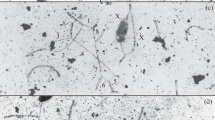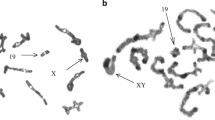Abstract
A survey is given on the occurrence, the geographic origin and the arm composition of 27 Robertsonian fusion metacentric chromosomes of wild populations of the mouse. Their study is of twofold interest: a) it is possible to introduce these naturally occurring metacentrics in laboratory strains for experimental use. At present, altogether 34 metacentric chromosomes of different composition are available including 7 cases of metacentrics known from laboratory strains of the mouse. b) With the search for metacentrics in the mouse and with their identification insights are permitted in the role of Robertsonian changes in the course of mammalian evolution — Several separate populations of the mouse with different sets of multiple (up to 9) metacentrics have been found in Switzerland and Italy. Some of the individual metacentrics may occur in different populations. The participation of an acrocentric autosome in the formation of metacentrics seem to be at random, but the sex chromosomes are never included in a metacentric. — Homology of the arms involved in metacentrics is conserved, so that in meiosis of interpopulation hybrids long chains or rings are observed. They may include up to 16 metacentrics arranged according to the alternating homologies of their arms. — Reduction of fertility of single or multiple metacentric heterozygotes and of the interpopulation hybrids is due to mechanisms of segregational imbalance and subsequent prenatal elimination of fetal offspring, but it follows also the pattern of male limited hybrid sterility. — From an evolutionary view point, karyotype rearrangements of Robertsonian type may initiate reproductive isolation, which prepares the ground for further genetic diversification and, as in the case of the mouse, of incipient speciation.
Similar content being viewed by others
References
Baranov, V.S., Dyban, A.P.: Embryogenesis and peculiarities of karyotype in mouse embryos with centric fusion of chromosomes (Robertsonian translocation). Ontogenez. 2, 164–176 (1971)
Capanna, E., Cristaldi, M., Perticone, P., Rizzoni, M.: Identification of chromosomes involved in the nine Robertsonian fusions of the Apennine mouse with a 22-chromosome karyotype. Experientia (Basel) 31, 294–296 (1975)
Cattanach, B.M., Moseley, M.: Nondisjunction and reduced fertility caused by the tobacco mouse metacentric chromosomes. Cytogenet. Cell Genet. 12, 264–287 (1973)
Cattanach, B.M., Savage, J.R.K.: A new Robertsonian translocation. Mouse Newsl. No. 54, Ed.: A.G. Searle, Harwell England, p. 38 (1976)
Chapman, H.M., Bruère, A.N.: The frequency of aneuploidy in the secondary spermatocytes of normal and Robertsonian translocation-carrying rams. J. Reprod. Fertil. 45, 333–342 (1975)
Committee on standardized genetic nomenclature for mice: Standard karyotype of the mouse. M. musculus. J. Hered. 63, 69–72 (1972) Mouse News Letter 50 (1974)
Evans, E.P., Breckon, G., Ford, C.E.: An air drying method for meiotic preparations from mammalian testes. Cytogenetics 3, 289–294 (1964)
Evans, E.P., Lyon, M.F., Daglish, M.: A mouse translocation giving a metacentric marker chromosome. Cytogenetics 6, 105–119 (1967)
Fatio, V.: Faune des Vertébrés de la Suisse. Vol. 1. Genève et Bâle: Georg 1869
Gropp, A., Giers, D., Kolbus, U.: Trisomy in the fetal backcross progeny of male and female metacentric heterozygotes of the mouse. Cytogenet. Cell Genet. 13, 511–535 (1974)
Gropp, A., Kolbus, U., Giers, D.: Systematic approach to the study of trisomy in the mouse. II. Cytogent. Cell Genet. 14, 42–62 (1975)
Gropp, A., Tettenborn, U., Lehmann, E. von: Chromosomenvariation vom Robertson'schen Typus bei der Tabakmaus M. poschiavinus und ihren Hybriden mit der Laboratoriumsmaus. Cytogenetics 9, 9–23 (1970)
Gropp, A., Winking, H., Zech, L., Müller, H.J.: Robertsonian chromosomal variation and identification of metacentric chromosomes in feral mice. Chromosoma (Berl.) 39, 265–288 (1972)
Haldane, J.B.S.: Sex ratio and unisexual sterility in hybrid animals. J. Genet. 12, 101–109 (1922)
Hilwig, I., Gropp, A.: Decondensation of constitutive heterochromatin in L cell chromosomes by a benzimidazole compound (“33258” Hoechst). Exp. Cell Res. 81, 474–477 (1973)
Léonard, A., Deknudt, G.H.: A new marker for chromosome studies in the mouse. Nature (Lond.) 214, 504–505 (1967)
Matthey, R.: Polymorphisme chromosomique intraspécifique et intraindividuel, chez Acomys minous Bate (Mammalia-Rodentia-Muridae). Chromosoma (Berl.) 14, 468–497 (1963)
Matthey, R.: Evolution chromosomique et spéciation chez les Mus du sous-genre Leggada Gray 1837. Experientia (Basel) 20, 657–665 (1964)
Matthey, R.: Le polymorphisme chromosomique des Mus africains du sous-genre Leggada. Révision générale portant sur l'analyse de 213 individus. Rev. Suisse Zool. 42, 585–607 (1966)
Matthey, R.: Nouvelles donnés sur la cytogénétique et la spéciation des Leggada (MammaliaRodentia-Muridae) Experientia (Basel) 26, 102–103 (1970)
Nadler, C.F., Lay, D.M., Hassinger. J.D.: Cytogenetic analyses of wild sheep populations in northern Iran. Cytogenetics 10, 137–152 (1971)
Stella, R., Gropp, A.: Variation of the DNA content of morphologically normal and abnormal spermatozoa in mice susceptible to irregular meiotic segregation. J. Reprod. Fert. 38, 335–346 (1974)
Tettenborn, U., Gropp, A.: Meiotic non-disjunction in mice and mouse hybrids. Cytogenetics 9, 272–283 (1970)
Wahrman, J.: Hybridization in nature between two chromosome forms of spiny mice. Chromosomes today 3, 294 (1972)
Wahrman, J., Zahavi, A.: Intra-generic difference in chromosome numbers of spiny mice (Rodentia: Murinae). Bull. Res. Council Israel 3, 265 (1953)
White, B.J., Tjio, J.-H.: A mouse translocation with 38 and 39 chromosomes but normal N.F. Hereditas 58, 284–296 (1968)
Winking, H., Gropp, A.: Meiotic non-disjunction of metacentric heterozygotes in oocytes versus spermatocytes. Serono Symp. 1975, New York: Academic Press (in press) 1976
Wurster, D.H., Benirschke, K.: Chromosome studies in the super family Bovidae. Chromosoma (Berl.) 25, 152–171 (1968).
Zahavi, A., Wahrman, J.: Chromosome races in the genus Acomys (Rodentia Murinae). Bull. Res. Council Israel B, 350E (1956)
Author information
Authors and Affiliations
Rights and permissions
About this article
Cite this article
Capanna, E., Gropp, A., Winking, H. et al. Robertsonian metacentrics in the mouse. Chromosoma 58, 341–353 (1976). https://doi.org/10.1007/BF00292842
Received:
Accepted:
Issue Date:
DOI: https://doi.org/10.1007/BF00292842




